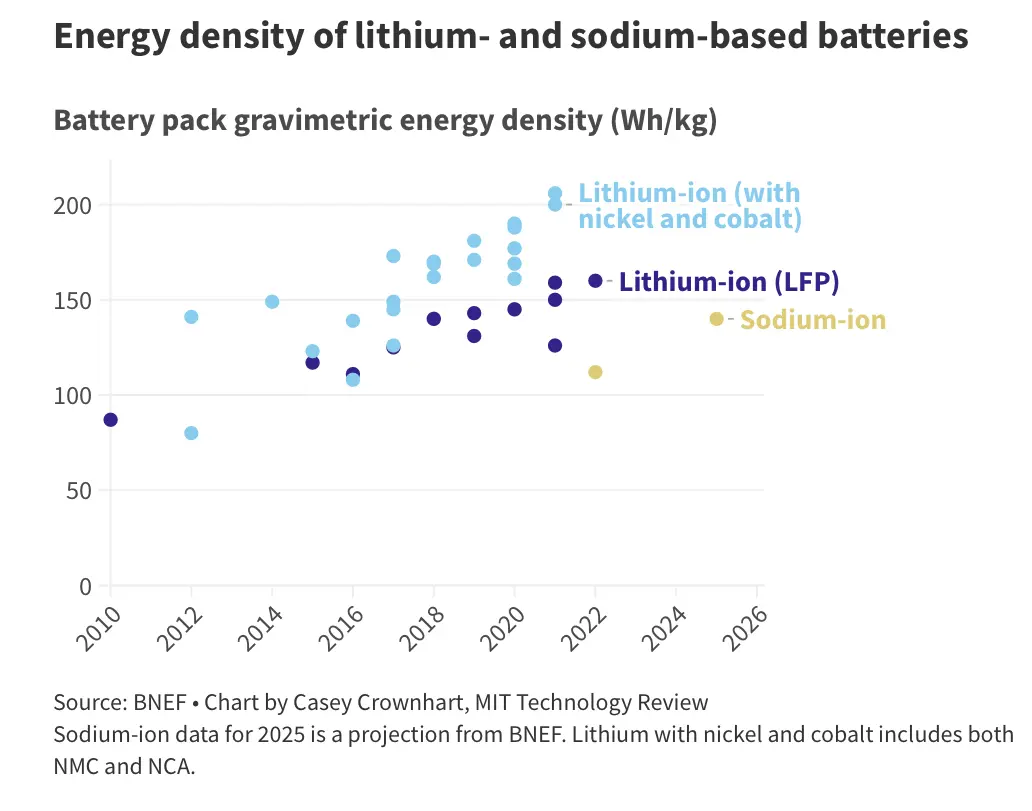It’s so rare to actually see a new battery tech exit the lab and enter production. Always seems like there’s 10,000 new up and coming breakthroughs in battery technology, but none ever leave the workbench.
While Na-ion batteries don’t have the energy density of Li-ion, they make up for it with many other factors such as more abundant source materials, increased safety, higher charge/discharge currents, and increased number of charge cycles.
Slashdot summary:
Not only is sodium somewhere between 500 to 1,000 times more abundant than lithium on the planet we call Earth, sourcing it doesn’t necessitate the same type of earth-scarring extraction. Even moving beyond the sodium vs lithium surname comparison, Natron says its sodium-ion batteries are made entirely from abundantly available commodity materials that also include aluminum, iron and manganese. Furthermore, the materials for Natron’s sodium-ion chemistry can be procured through a reliable US-based domestic supply chain free from geopolitical disruption. The same cannot be said for common lithium-ion materials like cobalt and nickel.
Sodium-ion tech has received heightened interest in recent years as a more reliable, potentially cheaper energy storage medium. While its energy density lags behind lithium-ion, advantages such as faster cycling, longer lifespan and safer, non-flammable end use have made sodium-ion an attractive alternative, especially for stationary uses like data center and EV charger backup storage. […] Natron says its batteries charge and discharge at rates 10 times faster than lithium-ion, a level of immediate charge/discharge capability that makes the batteries a prime contender for the ups and downs of backup power storage. Also helping in that use case is an estimated lifespan of 50,000 cycles.
Before anyone complains about energy density of these being less than lithium, the applications where these are used would reduce the demand for lithium, making lithium cheaper and/or more available for other purposes where sodium-ion wouldn’t work.
For anyone wondering how the density actually compares, it seems that sodium batteries are a bit more than half the energy density of the best lithium batteries, but are a less mature technology so that may improve over time.

Judging from that graph, it looks like the sodium ion batteries are about as energy dense as Li-ion was in 2020, which is far from useless. Li-ion may still be the best but at a point, there’s “good enough” for many applications (eg cellphones) if the price is low enough.
I would happily take a slight reduction in EV range if it meant the battery was significantly less expensive and the number of charge/discharge cycles would last the life of the car. Someone else said that with a rated 50,000 cycles, one charge cycle per day would last 137 years.
The li-po batteries do already last the life of the car to be fair.
True, but aren’t they a bit handicapped by only using the “middle” range of the battery in order to extend their useful life?
Though to also be fair, I don’t know if these sodium batteries require the same management techniques or not.
Not sure, but i get 420km range and it’s dropped less than 5% after 110,000km, does 0-100 in 5 seconds. To be honest that’s more than quick enough for me.
If it’s nerfed a bit i definitely don’t notice it.
They aren’t rated for 50,000 cycles. The ones I have seen are rated between Lithium Cobalt Oxide and Lithium Iron Phosphate batteries. They don’t even come close to Lithium Titanate in charge cycles.
Lithium Phosphate, yes. Most EVs don’t use that because it doesn’t do as well as full Li-ion. LFP is a safer chemistry, though.
Ebikes are where I hope this gets a lot of use. That and stationary applications.
True but it’s growing rapidly each year. The base model 3 Tesla uses them and there are a lot of those around.
Sodium based batteries have reached at least 247 Wh/kg in the lab at least. While lithium in the lab does have much higher instances, that isn’t far off from current commercially available Li-ion EV batteries.
While such sodium batteries are not commercially available, it at least shows their potential to reach close to current EV batteries (around ~270 Wh/kg).
Source: https://www.pv-magazine.com/2024/04/25/sodium-ion-battery-could-charge-in-several-seconds/
Sodium batteries are commercially available as of early this year. I’ve seen Hakadi and Sriko tested independently on Youtube – they’re the real deal (sodium has a unique charging curve), but they have the same/similar organic electrolyte as LFP cells (I believe Natron uses PBA on both anode and cathode plus water-based electrolyte).
https://srikobatteries.com/product-category/sodium-batteries/sodium-cells/
https://hakadibattery.com/collections/sodium-ion-battery-cells-3v
The linked batteries all appear to have energy densities of about 130 Wh/kg or less.
I wasn’t denying sodium batteries are not commercially available/viable, just pointing out that while currently available sodium batteries have lower energy density than lithium ion batteries, in the lab, sodium batteries have the ability to reach similar energy density to currently commercially available lithium ion batteries.
The linked batteries are plenty useful for many purposes. I would gladly use them for home energy storage, electronics, or recreation vehicle use. I’m generally wary of lithium battery safety in outdoor, or high heat environments, and look forward to safer options becoming more available/common.
These aren’t going to shine as “I want to power my rc plane” batteries, but as someone else said, “[a house-powering battery] can be as large as it needs to be and buried in the back yard”
I’d love a giant sodium battery in a bunker that gathers energy from my wind/solar setup and powers everything without needing to connect to the US power grid.
As long as I can service my own windmill and panels with extra parts (I’m a big believer in both “have a backup” and “two is one and one is none” so always keep 3 spares of things around) I’m set on power during events that would shut down the neighbors.
The lower cost (and battery cost has been lowering drastically for many years based on my own RC dealings) will allow for mass-storage at low prices.
Opponents of renewable energy are running out of excuses, so they have to grasp at straws.
Possibly also good for some cheap cars or e-bikes, as well. Save lithium for the use cases that really need it.
Would love to have a sodium house battery. It could be as large as it needs to be, and buried in the backyard.
lifespan of 50,000 cycles
If you cycle the battery once a day, that’s nearly 137 years.
Is it lifespan without reduction of capacity? Or lifespan until its dead?
It’s probably to the same standard as Li+'s lifespan, which would be until actual capacity falls below 80% of design capacity.
Battery technology is changing all the time, but it’s only highly visible when we switch fundamental systems. NiMH batteries had a number of improvements that increased energy density and charge cycles, but most users only saw they were NiMH batteries. The same applies to Li-ion batteries. Overall, rechargeable batteries have gotten 6 to 10 times as energy dense and cost has been reduced to about 5% per Ah over the last 30 years. This didn’t happen because research wasn’t leaving the lab.
All good points. The main takeaway here should really be about what this particular breakthrough offers, which is an abundant, more environmentally-friendly source material that could be used to replaceLi-Ion in a lot of use cases. And maybe most/all uses with its own improvements over time.
And also that advanced materials science is hard. Yes, there will be a lot of apparent dead ends as well as a lot of dead ends that lead to new paths of research when coupled with as-yet unperformed research. It may be cool to say, “Yet another piece of research that won’t leave the lab,” but all comments like that (and the upvotes they receive) indicate is the complete lack of understanding those users have about the field in question.
Anti-intellectualism is the bane of progress.
Thank you. I try to keep that same message out there. Yeah, headlines make outlandish claims all the time, but they’re all based on something, and every single one you heard in the last 20 years have added up to a revolution.
Although you’re probably aware, there are geo political implications as well.
Over the last decade China has taken control of the Lithium industry.
Anything we can do to avoid being forced to buy their stuff, honestly.
I know it’s salt(s) removal in desalination. Sodiums gotta be in there. This is an exciting battery development(finally), surely?
Na
Get out of here, you know what you did wrong.
Why so salty?
You don’t need to be so explosive. Be more like Argon.
I voted this comment from 1 to 2. It as close as I will get today to a perfect comment.
I set em up, CosmicTurtle0 knocks em down.
Definitely. This technology has showing up in a YouTube channel I’ve been watching for a while. Just Have A Think on YouTube does a pretty excellent job of tracking these kinds of advancements.
He did a video on NA batteries 3 months back, which was a follow-up to a 202(2?) video.
I seem to recall reading somewhere that these have better cold weather performance than lithium-ion? As a Canadian, I made a mental note this.
Just bought and installed 20kWh of gently used AGM batteries, hopefully by the time they wear out they’ll have been the last lead-acid cells I own. Nice to see sodium actually hit production.
The claimed 10x C rate of lithium would be insane as lithium already has great power density. At that point it’s practically a capacitor, and could even be used to replace the much hated automotive starting batteries. Wonder how it handles low temperatures.
We’ve had the technology to replace automotive batteries with Lithium ones for a long time already.
Honestly this sounds great.
China has been getting a bit creepy with their Lithium mine acquisitions. It would be nice to be less dependent on them.
Do we still throw them in the ocean when we’re done?
Will they charge the eels or blow them up?
And can eals be used as a living power generator ?
Only if it makes money
It helps maintain the salt content…
Impossible no batteries aside from Li Ion ever exit the lab.
sourcing it doesn’t necessitate the same type of earth-scarring extraction.
I guess they dont know how lithium is sourced.
the problem with lithium ion isn’t the lithium; it’s the cobalt etc
cobalt’s not necessary, and the article is specifically talking about lithium sourcing.
It’s also the lithium, or at least it is how it’s done now. Big shallow ponds of water in regions that are already strapped for water.
Several EVs are already cobalt-free.
That said, California’s salton sea is a very promising source of lithium. It’s already an industrial waste zone, but one we can make use of now.
its big shallow ponds of saltwater. Folks just feel like lithium has to have a monkey’s paw catch to it, but it’s one of the least ecologically damaging material to extract from the earth.
They’ll also be quite a bit heavier. Coupled with lower charge, expect heavier devices. I don’t see this happening on mobile phones, as much as I’d love it
I think they’ll be useful for applications where the energy per unit of mass isn’t what matters. So not vehicles and not mobile devices - but there are still a huge range of applications left, especially in a world where we urgently need to move from fossil fuels to abundant but intermittent sources like solar and wind energy.
Oh sure! Just like I said, nothing mobile
I could see myself with a heavier device, especcially if its safer from catching on fire. But mass market might disagree. Sodium battery replacments could be a thing for more modifiable devices though.
Removed by mod







